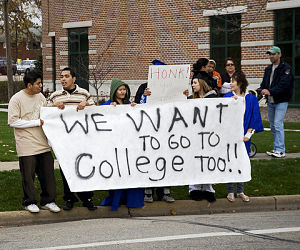Pricing the ‘Great Cost Shift’ in US Higher Ed
The US system of higher education, while lauded as a model to be emulated by the Australian government, is facing harsh criticism on home soil. With up to US$1 trillion in student debt owed to the government and graduates facing debts they cannot repay, calls are being made to fix a system that isn’t working.
In recent decades in the US, and now increasingly in Australia, education tends to be seen as an investment in human capital, rather than something that promotes the public good. In this way of thinking, students attend university primarily to acquire skills that can be cashed-in somewhere in the marketplace. Consequently, students, and often their parents, should be the ones responsible for the costs associated with obtaining these advanced university skills.
This belief has led to “the great cost shift” in the US. This shift has moved government support and subsidies of higher education students and facilities to various types of loan schemes, both privately and publicly backed, to be taken out by the student “investor-consumer.”

This article by Steven C. Ward originally appeared at The Conversation, a Social Science Space partner site, under the title “The costs of the ‘great cost shift’: lessons from the US”
Finally, this model creates a demand-driven and increasingly efficient market for education as universities compete with one another for “student business” as these loan-ladened students shop around for the right university and program.
Students and parents are assisted in this shopping spree by new consumer-type rankings that, like restaurant or hotel reviews, orders universities according to their “quality,” such as the Shanghai or Times Higher Education Rankings or the one currently being purposed by the Obama administration.
The US experience
In the US, the movement away from direct government grants toward student loan schemes has been unfolding for roughly three decades.
The US model for financing universities has used a combination of both government subsidized and non-subsidized student loans and private loans, many of which are serviced by the for-profit company Sallie Mae (now Navient). The result of this financing model has produced graduates who, in 2013, had loans averaging USD$29,400.
The total outstanding student loan debt in the US now stands somewhere between US$902 billion and US$1 trillion.
This loan scheme has been driven by declining state support for higher education institutions, which dropped from an average of 60.4% of university budgets in 1975 to 34.1 percent by 2010 with some states, such as Colorado, projected to reach 0 percent by 2017. Only one state, North Dakota, thanks to new oil money, saw an increase in state support over the last five years.
The great cost shift has hit the working and middle classes the hardest. While grants remain in place for students in the lowest income categories those slightly up the income ladder are deemed ineligible and are forced to rely more on loans either subsidized or not (some with interests as high as 7.9 percent).
The US is seeking change
The great cost shift and burgeoning student debt have created a dynamic political and policy environment in the US. Some have likened the crisis to the “housing bubble” that helped launch the Great Global Recession and have called for major reforms in the way higher education operates and is financed.
Inspired in part by the Occupy Movement’s focus on student debt, there are calls to make university education free, at least for the first two years. In recent months this movement for free tuition spawned plans in Tennessee, Oregon and Mississippi to make the first two years of college free.
Also being considered in some states is a type of middle ground position named “pay in forward” that would, like in the loan schemes in Australia and the UK, link payback with future income. This movement too has been gaining support and seems to be gaining traction with the Obama administration.
However, on the other side of the political spectrum sit the neoliberal privateers and “disruptive innovators”, who actually initiated the movement towards loans in the first place and continue to dominate most current thinking on higher education policy in the US. They see the rising cost of universities and soaring student loan debt as a reason to apply even more market pressures on universities.
They call for increased reliance on more low cost online alternatives such as MOOCs – particularly at second-tier state universities – as well as increased teaching loads and more part-time faculty.
Politicians on this side of the debate recently blocked a bill to allow students to refinance their loans at a lower rate because it was to be supported with a tax on millionaires.
America’s higher education outcomes over this three-decade experiment have been largely disastrous, particularly for middle and working-class students and their families. While it enabled more students to attend university than a system with no support, it also saddled many of these students with loads of debt, thereby delaying their personal lives and putting them at a further economic disadvantage compared to their wealthier peers.
It has, ironically, turned public institutions that were meant to be the “great equalizers” – by providing higher education for all – into the “great stratifiers”.
![]()




























































































